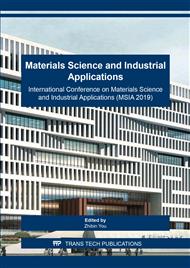[1]
B. Wang, X.H. Guo, P. Bai, Romoval technology of boron dissolved in aqueous solutions—A review. Colloid Surfaces A. 444(2014)338-344.
Google Scholar
[2]
Y. Xu, J.Q. Jiang, Technologies for Boron Removal. Ind. Eng. Chem. Res.47(2015) 16-24.
Google Scholar
[3]
J.Kang, Y. Tang, S. Gao, L. Liu,. One-dimensional controllable crosslinked polymers grafted with N-methyl-D-glucamine for effective boron adsorption. New J. Chem. 42(2018) 11334-11340.
DOI: 10.1039/c8nj00461g
Google Scholar
[4]
N. B. Darwish, V. Kochkodan, N. Hilal, Boron removal from water with fractionized Amberlite IRA 743 resin. Desalination, 370(2015)1-6.
DOI: 10.1016/j.desal.2015.05.009
Google Scholar
[5]
H. Hoshina, N. Seko, Y. Ueki, M. Tamada, Synthesis of Graft Adsorbent with N-Methyl- D-glucamine for Boron Adsorption. J. ion exchange18 (2007). 236–239.
DOI: 10.5182/jaie.18.236
Google Scholar
[6]
M.M. Nasef, T.M. Ting, A. Abbasi, A. Layeghi-Moghaddam, S.S. Alinezhad, Radiation grafted adsorbents for newly emerging environmental applications. Radiat. Phys. Chem. 118(2016)55-60.
DOI: 10.1016/j.radphyschem.2015.02.025
Google Scholar
[7]
T.M. Ting, M.M. Nasef, Modification of Polyethylene-polypropylene Fibers by Emulsion and Solvent Radiation Grafting Systems for Boron Removal. Fiber Polym 18(6) (2017)1048-1055.
DOI: 10.1007/s12221-017-6840-5
Google Scholar
[8]
M.R. Saeb, H. Garmabi, Investigation of styrene-assisted free-radical grafting of glycidyl methacrylate onto high-density polyethylene using response surface method. J. Appl. Polym. Sci., 111 (2009) 1600–1605.
DOI: 10.1002/app.29123
Google Scholar
[9]
M.M. Nasef, T.M. Ting, K. Hashim, Tuning N-methyl-D-glucamine density in a new radiation grafted poly (vinyl benzyl chloride)/nylon-6 fibrous boron-selective adsorbent using the response surface method. RSC Adv. 5(2015) 37869-37880.
DOI: 10.1039/c5ra00427f
Google Scholar
[10]
M. Tagliabue, A.P. Reverberi, R. Bagatin, Boron removal from water: needs, challenges and perspectives.J. Clean Prod. 77 (2014)56-64.
DOI: 10.1016/j.jclepro.2013.11.040
Google Scholar
[11]
X. Li, R. Liu, S. Wu, J. Liu, S.S. Cai, D.S. Chen, Efficient removal of boron acid by N-methyl-D-glucamine functionalized silica-polyallylamine composites and its adsorption mechanism. J. Colloin Interf Sci.361 (2011)232-237.
DOI: 10.1016/j.jcis.2011.05.036
Google Scholar
[12]
M. Shaban, M.R. Abukhadra, AAP. Khan, B.M. Jibali, Removal of Congo red, methylene blue and Cr (VI) ions from water using natural serpentine. J. Taiwan Inst. Chem. E. 82 (2018) 102-116.
DOI: 10.1016/j.jtice.2017.10.023
Google Scholar
[13]
Ting T.M., Hoshina H., Seko N., Tamada M. (2013) Removal of boron by boron-selective adsorbent prepared using radiation induced grafting technique. Desalination and Water Treatment, 51, 2602–2608.
DOI: 10.1080/19443994.2012.749054
Google Scholar
[14]
S. Nishihama, Y. Sumiyoshi, T. Ookubo, K. Yoshizuka. Adsorption of boron using glucamine- based chelate adsorbents. Desalination, 310 (2013) 81-86.
DOI: 10.1016/j.desal.2012.06.021
Google Scholar


